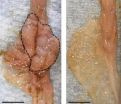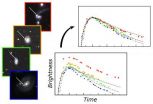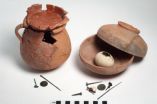(Press-News.org) ST. PAUL, Minn., March 4, 2014 – Higher temperatures, more heavy precipitation, and drought. It's all expected in the Central Hardwoods Region of southern Indiana, southern Illinois, and the Missouri Ozarks, according to a new report by the U.S. Forest Service, and partners that assesses the vulnerability of the region's forest ecosystems and its ability to adapt to a changing climate.
More than 30 scientists and forest managers contributed to the report, which is part of the Central Hardwoods Climate Change Response Framework, a collaboration of federal, state, academic and private partners led by the Forest Service's Northern Institute of Applied Climate Science (NIACS). "Central Hardwoods Ecosystem Vulnerability Assessment and Synthesis: A Report from the Central Hardwoods Climate Change Response Framework Project," was published by the U.S. Forest Service's Northern Research Station and is available online at: http://www.nrs.fs.fed.us/pubs/45430
"People often think of climate change as being distant, either geographically or temporally," said Leslie Brandt, the report's lead author and a climate change specialist with NIACS. "Our intent was to create a climate change resource that will be relevant to people who work, study, recreate, manage and care about the ecosystems in the Central Hardwoods Region."
In the Central Hardwoods, the effects of a changing climate are expected to include rising temperatures due to a rise in greenhouse gas concentrations, leading to longer growing seasons. Winter temperatures are also expected to increase in the area, leading to changes in snow cover and soil frost. The nature and timing of precipitation will change, research suggests, with some studies showing that climate change will decrease soil moisture later in the growing season.
Other findings of the vulnerability assessment include:
Conditions are expected to be less favorable for northern species such as sugar maple, American beech and white ash and become more suitable for southern species such as shortleaf pine.
Forest fragmentation, an existing stressor for the region's forests, may reduce the ability of species that are adapted to future climate conditions to expand into new areas.
Ecosystems that are adapted to frequent fire, such as open woodlands and savannas, may be more resilient to climate change because warmer temperatures are projected to increase the risk of wildfire.
"Plants, animals, and people all depend on forests and may all face additional challenges as temperatures increase and precipitation patterns shift," said John Shuey, a co-author of the study and Director of Conservation Science for the Indiana Chapter of The Nature Conservancy. "But we don't have to wait until these changes wreak havoc on our forest habitats. We can start managing for the future today by nudging our forests towards species adapted to withstand future climates."
More than a century of weather records demonstrate a changing climate for the Central Hardwoods, a region that is 40 percent forested, with about 80 percent of forested land privately owned. Since 1900, minimum temperatures in the Central Hardwood Region have increased by 1 to 2 degrees Fahrenheit and maximum temperatures have decreased by a similar amount. The region is receiving 12 to 17 percent more precipitation, particularly in the spring and fall since the turn of the last century. Over the past 30 years, more rain has been falling as heavy precipitation events of 3 inches or greater. Since the 1970s, a decrease in snow cover has led to an increase in soil frost.
"Confronting the challenge of climate change presents opportunities for managers and other decision-makers to plan ahead, foster resilient landscapes, and ensure that the benefits that forests provide are sustained into the future," said Michael T. Rains, Director of the Northern Research Station and the Forest Products Laboratory. "Forest Service science is delivering tools and data that will help managers in the Central Hardwoods and throughout the nation meet this challenge."
INFORMATION:
The Northern Institute of Applied Climate Science (NIACS) is a collaborative effort among the Forest Service, universities, and forest industry to provide information on managing forests for climate change adaptation, enhanced carbon sequestration, and sustainable production of bioenergy and materials. As a regional, multi-institutional entity, NIACS builds partnerships, facilitates research, and synthesizes information to bridge the gap between carbon and climate science research and the information and management needs of land owners and managers, policymakers, and members of the public.
The mission of the U.S. Forest Service is to sustain the health, diversity, and productivity of the nation's forests and grasslands to meet the needs of present and future generations. The agency has either a direct or indirect role in stewardship of about 80 percent of our nation's forests, amounting to 850 million acres including 100 million acres of urban forests gracing the nation's cities, where 80 percent of Americans live. The mission of the Forest Service's Northern Research Station is to improve people's lives and help sustain the natural resources in the Northeast and Midwest through leading-edge science and effective information delivery.
Report describes Central Hardwoods forest vulnerabilities, climate change impacts
2014-03-04
ELSE PRESS RELEASES FROM THIS DATE:
Exploring sexual orientation and intimate partner violence
2014-03-04
HUNTSVILLE, TX (3/4/14) -- Two studies at Sam Houston State University examined issues of sexual orientation and intimate partner violence, including its impact on substance abuse and physical and mental health as well as the effects of child abuse on its victims.
"We wanted to see how characteristics of the victims might differ based on if they were heterosexual or non-heterosexual," said Maria Koeppel, a Ph.D. student at the College of Criminal Justice, who coauthored the studies with Dr. Leana Bouffard. "These studies show the need to have specialized programs designed ...
New probes from Scripps research quantify folded and misfolded protein levels in cells
2014-03-04
LA JOLLA, CA – March 4, 2014 – Scientists at The Scripps Research Institute (TSRI) have invented small-molecule folding probes that enable them to quantify functional, normally folded and disease-associated misfolded conformations (shapes) of a protein-of-interest in cells under different conditions.
Scientists have long needed better tools for making such measurements in cells, because protein misfolding is a major cause of damage to tissues. Disorders that feature excessive protein misfolding afflict millions of people worldwide and include Alzheimer's and Parkinson's ...
Gene transfer optimization
2014-03-04
Lentiviruses, which belong to the family of retroviruses, are used as vectors to exchange genetic material in cells and can be used to replace a defective gene as defined by gene therapy. Increasing the efficiency of such a treatment poses a major medical challenge: the virus should specifically track the target cells, but the number of virus used should be as low as possible.
A research team led by Dr. Ines Höfig and Dr. Natasa Anastasov from the Institute of Radiation Biology (ISB) at Helmholtz Zentrum München in cooperation with Sirion Biotech GmbH in Munich and the ...
Screening does not shift breast cancer to earlier stages
2014-03-04
Screening for breast cancer appeared to have a very limited effect on the occurrence of serious and aggressive cancer cases. On the other hand, it appeared to detect many more early cancer cases, cases which would otherwise never have developed - but which are treated due to screening.
This is the conclusion of a study from Aarhus University, Denmark, that has just been published in the European Journal of Public Health based on data from all women over the age of 20 in Norway (approx. 1.8 million in 2010).
Looks at the various stages of cancer
The new element is that ...
Pulling polymers leads to new insights into their mechanical behavior
2014-03-04
In collaboration with colleagues from Berlin and Madrid, researchers at the Department of Physics at the University of Basel have pulled up isolated molecular chains from a gold surface, using the tip of an atomic force microscope (AFM). The observed signal provides insight into the detachment force and binding energy of molecules. The results have been published in the renowned scientific journal PNAS.
Atomic force microscopy is a method normally used for imaging matter with very high resolution. The sharp tip of the microscope is used to scan the surface line by line. ...
Yoga regulates stress hormones and improves quality of life for women with breast cancer undergoing radiation therapy
2014-03-04
HOUSTON — For women with breast cancer undergoing radiation therapy, yoga offers unique benefits beyond fighting fatigue, according to research from The University of Texas MD Anderson Cancer Center.
The preliminary findings were first reported in 2011 by Lorenzo Cohen, Ph.D., professor and director of the Integrative Medicine Program at MD Anderson, and are now published in the Journal of Clinical Oncology. This research is part of an ongoing effort to scientifically validate mind-body interventions in cancer patients and was conducted in collaboration with India's ...
Eliminating bacteria, changing lifestyle could lower risk in people genetically susceptible to colorectal cancer
2014-03-04
New York, NY— Bacteria in the gut are essential for the development of intestinal tumors in mice, according to research led by investigators from the Icahn School of Medicine at Mount Sinai. Removing the bacteria may play a critical role in reducing cancer risk, the researchers write, in the March issue of the Journal of Experimental Medicine.
Sergio A. Lira, MD, PhD, Director of the Immunology Institute, and Professor of Immunology and Medicine, and his laboratory at the Icahn School of Medicine at Mount Sinai, used a transgenic mouse model to test the hypothesis that ...
Standard-candle supernovae are still standard, but why?
2014-03-04
Sixteen years ago two teams of supernova hunters, one led by Saul Perlmutter of the U.S. Department of Energy's Lawrence Berkeley National Laboratory (Berkeley Lab), the other by Brian Schmidt of the Australian National University, declared that the expansion of the universe is accelerating – a Nobel Prize-winning discovery tantamount to the discovery of dark energy. Both teams measured how fast the universe was expanding at different times in its history by comparing the brightnesses and redshifts of Type Ia supernovae, the best cosmological "standard candles."
These ...
Virtual bees help to unravel complex causes of colony decline
2014-03-04
Scientists have created an ingenious computer model that simulates a honey bee colony over the course of several years. The BEEHAVE model, published today in the Journal of Applied Ecology, was created to investigate the losses of honeybee colonies that have been reported in recent years and to identify the best course of action for improving honeybee health.
A team of scientists, led by Professor Juliet Osborne from the Environment and Sustainability Institute, University of Exeter (and previously at Rothamsted Research), developed BEEHAVE, which simulates the life of ...
Sardis dig yields enigmatic trove: Ritual egg in a pot
2014-03-04
MADISON, Wis. — By any measure, the ancient city of Sardis — home of the fabled King Croesus, a name synonymous with gold and vast wealth, and the city where coinage was invented — is an archaeological wonder.
The ruins of Sardis, in what is now Turkey, have been a rich source of knowledge about classical antiquity from the 7th century B.C., when the city was the capital of Lydia, through later Greek and Roman occupations.
Now, however, Sardis has given up another treasure in the form of two enigmatic ritual deposits, which are proving more difficult to fathom than ...






